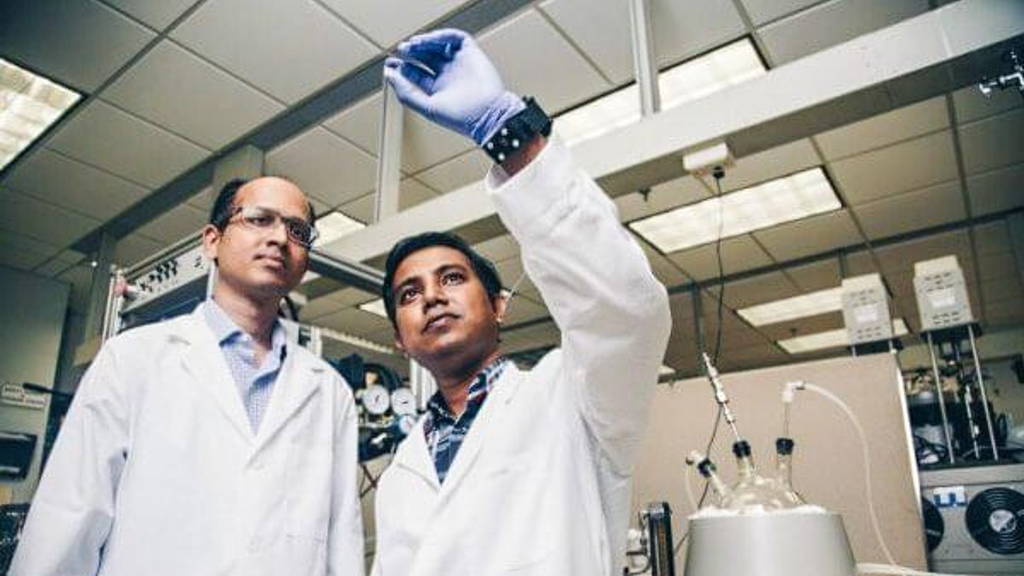How it works: activity trackers monitor your steps; the innovative sensor developed at FIU measures your blood alcohol level. Worn like a watch, this sensor picks up vapors from the skin and sends the data to a server. If the alcohol reading is high, via an app, a designated loved one gets an alert to check in on the user. This easy-to-wear gadget will help address issues with social drinking and addiction.
“We wanted to create an unobtrusive sensor that would be easy to wear, and help people struggling with alcohol,” said the inventor, Shekhar Bhansali, an Alcatel Lucent professor and chair of the Department of Electrical and Computer Engineering. “This is one step toward active intervention that only requires the user wear the sensor.”
Bhansali explains that people struggling with alcoholism typically will lapse when it comes to self-reporting their alcohol intake. Also, alcohol clears the body within eight hours so someone who has to take a urine test in the morning can technically sleep off any binge drinking they may have undergone the night before.
“The calibrated sensor acts like an ‘electronic nose;’ it can sense alcohol odor from the skin in a fraction of second,” said Yogeswaran Umasankar, a research assistant professor working with Bhansali.
In addition to managing alcoholism, this wearable sensor may help monitor social drinking on college campuses. It can also help keep an eye on liver transplant patients who are unable to drink or risk additional liver damage
Only last May Propeller Health created the Propeller sensor to help patients with respiratory problems. The sensor is placed on top of the patients’ inhaler and uses Bluetooth to connect with the patients’ smartphone. The Propeller sensor records the exact time and location of a patient’s asthma attack. The collected information subsequently gives doctors more of an insight into the environmental triggers of asthma attacks.
The CardioInsight Noninvasive 3D Mapping System is a single-use, disposable wearable. It received FDA 510(k) clearance last February, following a predecessor system that was used in more than 1,600 patients. In addition to having the benefit of being non-invasive, the vest may also give physicians more insights, as it can be worn long enough to catch transient arrhythmias that could otherwise be missed on a one-time ECG test.
Click here for a brief video about the sensor technology
###sensor###
“We wanted to create an unobtrusive sensor that would be easy to wear, and help people struggling with alcohol,” said the inventor, Shekhar Bhansali, an Alcatel Lucent professor and chair of the Department of Electrical and Computer Engineering. “This is one step toward active intervention that only requires the user wear the sensor.”
Costs of excessive drinking
According to the Centers for Disease Control (CDC), excessive drinking cost the American economy $249 billion in 2010. Alcohol abuse is also known to kill about 88,000 people in the United States every year.Bhansali explains that people struggling with alcoholism typically will lapse when it comes to self-reporting their alcohol intake. Also, alcohol clears the body within eight hours so someone who has to take a urine test in the morning can technically sleep off any binge drinking they may have undergone the night before.
Detecting alcohol off the skin
The wearable sensor detects alcohol off the skin within 15 to 20 minutes of consumption. The device is made from start to finish by engineers. First, they create the alcohol sensors in a hot press. Then they test and calibrate the sensor with a gas sensing setup. Once the sensor reads the expected alcohol levels, engineers wire the sensor to the board, print the interface for the device on a 3D printer, and then assemble it all together.“The calibrated sensor acts like an ‘electronic nose;’ it can sense alcohol odor from the skin in a fraction of second,” said Yogeswaran Umasankar, a research assistant professor working with Bhansali.
In addition to managing alcoholism, this wearable sensor may help monitor social drinking on college campuses. It can also help keep an eye on liver transplant patients who are unable to drink or risk additional liver damage
Everyday technology
Wearable sensors are becoming everyday technology in healthcare, used for easier telemonitoring (like monitoring realtime glucose levels) or to warn people with certain conditions for impending problems - like epileptic seizures.Only last May Propeller Health created the Propeller sensor to help patients with respiratory problems. The sensor is placed on top of the patients’ inhaler and uses Bluetooth to connect with the patients’ smartphone. The Propeller sensor records the exact time and location of a patient’s asthma attack. The collected information subsequently gives doctors more of an insight into the environmental triggers of asthma attacks.
Less invasive procedures
Other applications involve making monitoring procedures less invasive, such as finding out what the cause of an irregular heartbeat is. Up to now, the process involves an invasive procedure: most often, electrophysiologists insert a catheter to the heart via an artery or vein to get a cardiac ‘map and identify the origin of the arrhythmia. Now a new device from Medtronic takes the process outside, in the form of a sensor-enabled vest.The CardioInsight Noninvasive 3D Mapping System is a single-use, disposable wearable. It received FDA 510(k) clearance last February, following a predecessor system that was used in more than 1,600 patients. In addition to having the benefit of being non-invasive, the vest may also give physicians more insights, as it can be worn long enough to catch transient arrhythmias that could otherwise be missed on a one-time ECG test.
Click here for a brief video about the sensor technology
###sensor###








